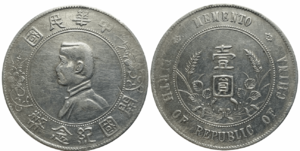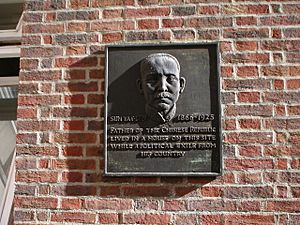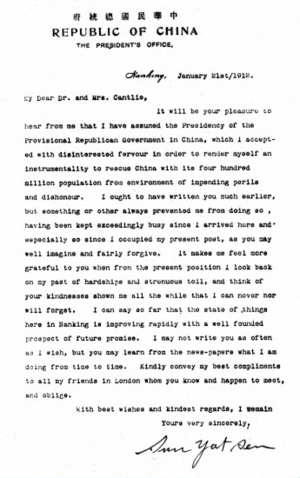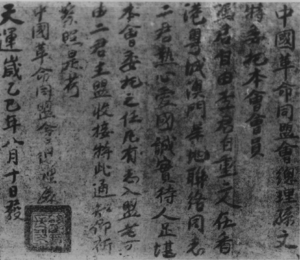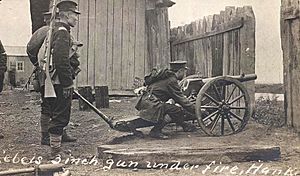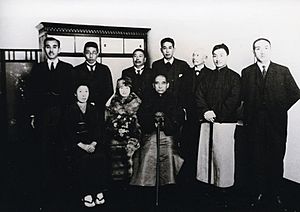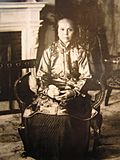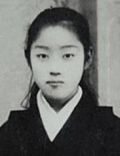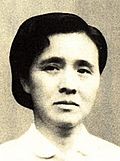Sun Yat-sen facts for kids
Quick facts for kids
Father of the Republic of China
Eternal Premier of the Kuomintang Sun Yat-sen
|
|||||||||||||||||||||||||||
|---|---|---|---|---|---|---|---|---|---|---|---|---|---|---|---|---|---|---|---|---|---|---|---|---|---|---|---|
|
孫中山
|
|||||||||||||||||||||||||||
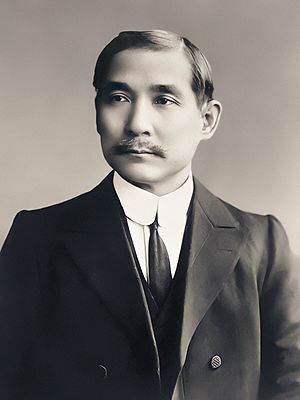
Photograph of Sun Yat-sen, c. 1911
|
|||||||||||||||||||||||||||
| Provisional President of the Republic of China | |||||||||||||||||||||||||||
| In office 1 January 1912 – 10 March 1912 |
|||||||||||||||||||||||||||
| Vice President | Li Yuanhong | ||||||||||||||||||||||||||
| Preceded by | Office established | ||||||||||||||||||||||||||
| Succeeded by | Yuan Shikai | ||||||||||||||||||||||||||
| Premier of the Kuomintang | |||||||||||||||||||||||||||
| In office 10 October 1919 – 12 March 1925 |
|||||||||||||||||||||||||||
| Preceded by | Office established | ||||||||||||||||||||||||||
| Succeeded by | Zhang Renjie (as Chairman) | ||||||||||||||||||||||||||
| Personal details | |||||||||||||||||||||||||||
| Born |
Sun Te-ming (孫德明)
12 November 1866 Cuiheng Village, Hsiangshan County, Kwangtung Province, Qing Empire |
||||||||||||||||||||||||||
| Died | 12 March 1925 (aged 58) Peking Union Medical College Hospital, Peking, Republic of China |
||||||||||||||||||||||||||
| Cause of death | Gallbladder cancer | ||||||||||||||||||||||||||
| Resting place | Sun Yat-sen Mausoleum, Nanjing, Jiangsu, China | ||||||||||||||||||||||||||
| Political party | Kuomintang | ||||||||||||||||||||||||||
| Other political affiliations |
Chinese Revolutionary Party Chinese United League Revive China Society |
||||||||||||||||||||||||||
| Spouses |
Lu Muzhen
(m. 1885; div. 1915)Kaoru Otsuki
(m. 1905; a. 1906) |
||||||||||||||||||||||||||
| Domestic partners | Chen Cuifen (concubine; 1892–1925) Haru Asada (concubine; 1897–1902) |
||||||||||||||||||||||||||
| Children | Sun Fo Sun Yan Sun Wan Fumiko Miyagawa |
||||||||||||||||||||||||||
| Parents |
|
||||||||||||||||||||||||||
| Education | University of Hong Kong (MD) | ||||||||||||||||||||||||||
| Occupation | Politician, writer, physician | ||||||||||||||||||||||||||
| Awards | Grand Merit Order (awarded by President Yuan Shikai but declined by Sun himself) | ||||||||||||||||||||||||||
| Signature (Chinese) |  |
||||||||||||||||||||||||||
| Signature | |||||||||||||||||||||||||||
| Military service | |||||||||||||||||||||||||||
| Allegiance | |||||||||||||||||||||||||||
| Branch/service | |||||||||||||||||||||||||||
| Years of service | 1917–1925 | ||||||||||||||||||||||||||
| Rank | Generalissimo/Grand Marshal | ||||||||||||||||||||||||||
| Battles/wars |
|
||||||||||||||||||||||||||
| Chinese name | |||||||||||||||||||||||||||
| Traditional Chinese | 孫逸仙 | ||||||||||||||||||||||||||
| Simplified Chinese | 孙逸仙 | ||||||||||||||||||||||||||
|
|||||||||||||||||||||||||||
| Sun Jih-hsin | |||||||||||||||||||||||||||
| Traditional Chinese | 孫日新 | ||||||||||||||||||||||||||
| Simplified Chinese | 孙日新 | ||||||||||||||||||||||||||
|
|||||||||||||||||||||||||||
| Sun Chung-shan | |||||||||||||||||||||||||||
| Traditional Chinese | 孫中山 | ||||||||||||||||||||||||||
| Simplified Chinese | 孙中山 | ||||||||||||||||||||||||||
|
|||||||||||||||||||||||||||
| Sun Wen | |||||||||||||||||||||||||||
| Traditional Chinese | 孫文 | ||||||||||||||||||||||||||
| Simplified Chinese | 孙文 | ||||||||||||||||||||||||||
|
|||||||||||||||||||||||||||
| Sun Tsai-chih (courtesy name) |
|||||||||||||||||||||||||||
| Traditional Chinese | 孫載之 | ||||||||||||||||||||||||||
| Simplified Chinese | 孙载之 | ||||||||||||||||||||||||||
|
|||||||||||||||||||||||||||
| Sun Te-ming | |||||||||||||||||||||||||||
| Traditional Chinese | 孫德明 | ||||||||||||||||||||||||||
| Simplified Chinese | 孙德明 | ||||||||||||||||||||||||||
|
|||||||||||||||||||||||||||
Sun Yat-sen (/ˈsʌn ˌjætˈsɛn/; also known by many other names; 12 November 1866 – 12 March 1925) was a Chinese statesman and doctor. He is famous for being the first provisional president of the Republic of China. He also led the Kuomintang (Nationalist Party of China).
Sun Yat-sen is called the "Father of the Nation" in Taiwan. In mainland China, he is known as the "Forerunner of the Revolution." This is because he played a huge role in ending the Qing dynasty during the Xinhai Revolution. He is respected by both the Communist Party in Mainland China and the Nationalist Party in Taiwan.
Even though he was a great leader, Sun Yat-sen's political life was full of challenges. After the 1911 revolution, he quickly stepped down as president. He gave the position to Yuan Shikai. Sun then went to Japan for safety. Later, he returned to China to create a new government in the South. This government challenged the powerful warlords who controlled much of the country.
In 1923, Sun invited leaders from the Communist International to help reorganize his party. He formed an alliance with the Chinese Communist Party. Sun Yat-sen died on 12 March 1925, from gallbladder cancer. He did not live to see his party unite China. His successor, Chiang Kai-shek, completed this task in the Northern Expedition.
Sun's main idea was his political philosophy called the Three Principles of the People. These principles are:
- Mínzú (民族主義; Mínzúzhǔyì) or nationalism: This means China should be independent and free from foreign control.
- Mínquán (民權主義; Mínquánzhǔyì) or "rights of the people": This is about having a democracy, where people have a say in their government.
- Mínshēng (民生主義; Mínshēngzhǔyì) or people's livelihood: This focuses on the well-being and welfare of all citizens.
Contents
Sun Yat-sen's Many Names
Sun Yat-sen had many names throughout his life. His family name was Sun Deming (孫德明). As a child, his nickname was Tai Tseung (帝象). When he went to school, his teacher gave him the name Sun Wen (孫文). This is the name he used for most of his life.
While studying in Hong Kong, he got the name Yat-sen (Chinese: 逸仙; pinyin: Yìxiān). The name Sun Zhongshan (孫中山) is very popular in China. It comes from his Japanese name, Kikori Nakayama (中山樵). This was a secret name he used while hiding in Japan. His hometown was even renamed Zhongshan in his honor after his death.
Early Life and Education
Birth and Childhood
Sun Te-ming was born on 12 November 1866. His parents were Sun Dacheng and Madame Yang. He was born in Cuiheng village, in what is now Zhongshan City, Guangdong province. His family had a mix of Hakka and Cantonese backgrounds. His father owned little land and worked as a tailor.
Schooling in Hawaii
When he was 13, in 1878, Sun went to live with his older brother, Sun Mei, in Honolulu, Hawaii. His brother helped pay for his education. Sun Mei later became a big supporter of the revolution against the Qing dynasty.
In Honolulu, Sun Yat-sen attended ʻIolani School. There, he learned English, British history, math, science, and about Christianity. He quickly learned English and even won an award from King David Kalākaua. After graduating in 1882, he briefly attended Oahu College. In 1883, he was sent back to China because his brother worried he was becoming too Christian.
Studies in Hong Kong
Back in China in 1883, Sun met his childhood friend Lu Haodong. They were upset by old traditions and caused a stir at a local temple. They then escaped to Hong Kong. In Hong Kong, he studied at the Diocesan Home and Orphanage. From 1884 to 1886, he attended The Government Central School.
In 1886, Sun began studying medicine at the Guangzhou Boji Hospital. He later attended the Hong Kong College of Medicine for Chinese. This school is now part of the University of Hong Kong. He earned his medical license in 1892. He was one of only two students in his class to graduate.
Becoming a Revolutionary Leader
The Four Bandits
Around 1888, Sun was in Hong Kong with friends who shared his revolutionary ideas. They were called the Four Bandits. Sun was very frustrated with the old-fashioned Qing government. He felt they refused to learn from more advanced Western countries. So, he stopped practicing medicine to focus on changing China.
Founding the Revive China Society
In 1891, Sun met Yeung Ku-wan, who led the Furen Literary Society. This group wanted to overthrow the Qing dynasty. In 1894, Sun wrote a long letter to a Qing official, Li Hongzhang. He shared his ideas for modernizing China. He traveled to Tianjin to give the letter in person but was not allowed to meet Li.
After this, Sun decided that revolution was the only way. He went to Hawaii and started the Revive China Society. This group was dedicated to making China prosperous through revolution. Its members were mostly Chinese people living abroad. The Furen Literary Society later joined with the Revive China Society in Hong Kong. Sun became the secretary, and Yeung Ku-wan was the president.
Early Uprisings and Exile
In 1895, the Revive China Society planned the First Guangzhou uprising against the Qing government. However, their plans were discovered. Many members were caught, and the uprising failed. Sun received financial help from his brother, who sold much of his land in Hawaii.
In 1896, while in London, Sun Yat-sen was held captive at the Chinese Legation. The Chinese secret service wanted to send him back to China to execute him. But after 12 days, he was released thanks to his former teacher, James Cantlie, and British newspapers. This event made Sun a hero in the UK. He later wrote a book about it called "Kidnapped in London."
After this, Sun traveled to Japan for exile. There, he met Japanese politicians who supported his goal of opposing Western influence in Asia. He also befriended Mariano Ponce, a diplomat from the First Philippine Republic. Sun tried to help the Philippines get weapons for their fight for independence. He hoped that a free Philippines could help his revolution in China.
Uniting Revolutionary Forces
The Huizhou Uprising
On 22 October 1900, Sun ordered another uprising, the Huizhou uprising. This was five years after the failed Guangzhou uprising. This time, he asked for help from the triads. But this uprising also failed.
Gaining Support Abroad
Sun Yat-sen traveled to many countries to gain support and money for his cause.
- Thailand: In 1903, he secretly visited Bangkok. He spoke on Yaowarat Road, in Bangkok's Chinatown, telling overseas Chinese they were "the Mother of the Revolution." This street was later named "Sun Yat Sen Street" in his honor.
- United States: In 1904, Sun needed a special certificate to enter the United States due to the Chinese Exclusion Act of 1882. He obtained a Hawaiian birth certificate, which helped him get in. He then traveled across the US to raise funds.
- Malaysia and Singapore: Sun also gained strong support from Chinese merchants in Malaya (now Malaysia and Singapore). The Wan Qing Yuan villa in Singapore became the headquarters of his revolutionary group.
Forming the Tongmenghui
In 1904, Sun Yat-sen set a clear goal: "to expel the Manchu (Qing rulers), to revive China, to establish a Republic, and to distribute land equally among the people."
On 20 August 1905, Sun united with Chinese students in Tokyo to form the Tongmenghui (United League). This group organized many uprisings in China. By 1906, it had nearly 1,000 members. To spread their ideas, they started newspapers like Chong Shing Yit Pao and opened reading clubs across Singapore and Malaysia.
More Uprisings and Challenges
From 1907 to 1908, Sun led several more uprisings, including the Zhennanguan uprising. All of these attempts failed. Because of these failures, some members of the Tongmenghui questioned Sun's leadership. They even accused him of seeking personal gain. To avoid these problems, the Tongmenghui headquarters moved from Singapore to Penang in 1910.
The 1911 Revolution
To fund more uprisings, Sun asked for money at the 1910 Penang conference in November 1910. His supporters raised a lot of money. On 27 April 1911, revolutionary Huang Xing led the Yellow Flower Mound revolt in Guangzhou. This revolt also failed, and those who died are remembered as heroes.
The big breakthrough came on 10 October 1911, with the Wuchang Uprising. This military revolt, also led by Huang Xing, grew into the Xinhai Revolution. This revolution finally overthrew the last Emperor, Puyi, ending over 2,000 years of imperial rule in China. Sun Yat-sen was in the United States at the time, seeking support. He learned about the successful rebellion from newspaper reports and quickly returned to China.
Founding the Republic of China
Provisional Government
On 29 December 1911, representatives from various provinces met in Nanjing. They elected Sun Yat-sen as the "provisional president." January 1, 1912, was declared the first day of the Republic. Li Yuanhong became vice-president, and Huang Xing was the army minister. The new Provisional Government was formed, along with its first constitution. Sun is praised for funding the revolutions and keeping the revolutionary spirit alive. He also successfully united smaller revolutionary groups into one strong party.
Yuan Shikai Takes Over
Yuan Shikai, who controlled the powerful Beiyang Army in northern China, was promised the presidency if he could make the Qing emperor step down. On 12 February 1912, Emperor Puyi did abdicate. Sun Yat-sen then stepped down as president, and Yuan became the new provisional president in Beijing on 10 March 1912. The provisional government in Nanjing did not have its own strong military.
In May 1912, the new legislative assembly moved from Nanjing to Beijing. Many revolutionaries were worried about Yuan's growing power.
The Kuomintang and Second Revolution
Song Jiaoren, a Tongmenghui member, tried to gain control of the parliament. He combined the old Tongmenghui with other small parties to form the new Kuomintang (Chinese Nationalist Party) on 25 August 1912. The Kuomintang won many seats in the 1912–1913 elections. However, Song Jiaoren was assassinated on 20 March 1913, likely by Yuan's order.
In response, Sun and the Kuomintang launched the Second Revolution in July 1913 to overthrow Yuan. This revolt failed, and Sun Yat-sen fled to Japan in August 1913.
Warlord Era
In 1915, Yuan Shikai tried to make himself emperor of China. Sun Yat-sen joined the fight against him, which led to the start of the Warlord Era. During this time, different military leaders controlled different parts of China. Sun Yat-sen believed China needed to be unified.
Alliance with the Communist Party
Guangzhou Government

China was divided by regional military leaders. Sun returned to China in 1916 to push for unity. In 1921, he set up a military government in Guangzhou and was elected Grand Marshal. This government was meant to challenge the Beiyang government in the North. On 10 October 1919, Sun officially brought back the Kuomintang.
Working with Communists

Sun became convinced that China could only be unified through military action. He decided to work with the Communist Party of China (CCP). In January 1923, Sun and the Soviet Union's Adolph Joffe signed an agreement. Sun accepted communist members into his Kuomintang. Vladimir Lenin, the Soviet leader, praised Sun and his ideas. Sun also admired Lenin.
With Soviet help, Sun built up military power for the Northern Expedition. He founded the Whampoa Military Academy near Guangzhou. Chiang Kai-shek became its leader. This cooperation between the Kuomintang and the Communist Party was called the First United Front.
Final Years and Death
In 1924, Sun appointed his brother-in-law, T. V. Soong, to create the first Chinese Central Bank. This was a big step for the Kuomintang's goal of national capitalism.
In February 1923, Sun gave a speech at the University of Hong Kong. He said that China's problems and Hong Kong's stability inspired him to become a revolutionary. He also spoke about his Three Principles of the People as the country's foundation. Part of this speech became the National Anthem of the Republic of China.
On 10 November 1924, Sun traveled north to Tianjin. He called for a "national conference" to end warlord rule and cancel unfair treaties with Western powers. Two days later, despite his failing health, he went to Beijing to discuss China's future. He died in Beijing on 12 March 1925, at age 58. For many years, people thought he died of liver cancer. However, a later review of his autopsy report in 2016 showed he died from adenocarcinoma in his gallbladder that had spread to his liver.
Sun's body was moved to the Temple of Azure Clouds outside Beijing. He left a short political will that greatly influenced China's future. In 1929, his remains were moved to the majestic Sun Yat-sen Mausoleum in Nanjing.
Sun Yat-sen's Legacy
Power Struggles After His Death

After Sun's death, his followers fought over who should lead. His young student Chiang Kai-shek and his old comrade Wang Jingwei both wanted to claim Sun's legacy. In 1927, Chiang Kai-shek married Soong Mei-ling, the sister of Sun's widow Soong Ching-ling. This helped Chiang claim a closer connection to Sun. When the Communists and the Kuomintang split in 1927, starting the Chinese Civil War, both sides claimed to be Sun's true heirs. Sun's widow, Soong Ching-ling, supported the Communists.
Father of the Nation

Sun Yat-sen is still highly respected in both mainland China and Taiwan. In Taiwan, he is known as the Father of the Republic of China. His image is often seen in important places like government buildings and schools. He also appears on new money.
Forerunner of the Revolution
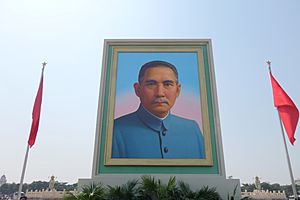
In mainland China, Sun is seen as a Chinese nationalist and the first president of a Republican China. He is called the Forerunner of the Revolution (革命先行者). He is even mentioned in the introduction to China's constitution. The Communist Party of China often refers to Sun to promote Chinese nationalism and connect with the Kuomintang in Taiwan. A large portrait of Sun appears in Tiananmen Square on important holidays.
In 1956, Mao Zedong said, "Let us pay tribute to our great revolutionary forerunner, Dr. Sun Yat-sen!"
Economic Ideas
Sun Yat-sen was impressed by the economic growth he saw in Hawaii. He used Hawaii as a model for his vision of a modern, independent China. He proposed that the government should control large businesses. He also wanted to support smaller businesses run by people. He believed that China should be equal with other nations, and all Chinese people should have equal opportunities.
He also thought that using foreign money could help China build a future socialist society. He believed in making capitalism help create socialism in China. Sun was also influenced by economist Henry George and his ideas about land ownership.
New Three Principles of the People
The Communist Party of China has reinterpreted Sun's Three Principles of the People. They argue that communism is a natural outcome of these principles. This reinterpretation is called the New Three Principles of the People. It suggests that the Communist Party is better at carrying out Sun's ideas. It also emphasizes allying with communists and Russians, and supporting farmers and workers.
In 2001, Sun's granddaughter, Lily Sun, said that the Communist Party was changing Sun's legacy. She expressed her unhappiness about this distortion of history.
Family Life
Sun Yat-sen was born to Sun Dacheng and Madame Yang. He had several older siblings. At age 20, Sun had an arranged marriage with Lu Muzhen. They had a son, Sun Fo, and two daughters, Sun Jinyuan and Sun Jinwan. Sun Fo's grandson, Leland Sun, became an actor and stuntman in Hollywood.
Sun later married Soong Ching-ling on 25 October 1915, in Japan. Soong Ching-ling's father, Charles Soong, was a friend of Sun's. However, Charles was upset about the marriage because Sun already had a wife. Soong Ching-ling's sister, Soong Mei-ling, later married Chiang Kai-shek.
Writings
- Kidnapped in London (1897)
- The Outline of National Reconstruction/Chien Kuo Ta Kang (1918)
- The Fundamentals of National Reconstruction/Jianguo fanglue (1924)
- The Principle of Nationalism (1953)
See also
 In Spanish: Sun Yat-sen para niños
In Spanish: Sun Yat-sen para niños
- Chiang Kai-shek
- History of Taiwan
- Politics of the Republic of China
- Sun Yat-sen Museum Penang
- Zhongshan suit
- Kuomintang
- Three Principles of the People


